Purchasing at a Time of Uncertainty
The pandemic has been one of the most devastating times in the world. I have often felt concerned about getting the virus and losing loved ones. For much of the world, time has been at a standstill. Some people were let go from work and had no income coming in. As the world started to re-open, my comfort levels have had to adjust as social distancing was put into place. With masks being mandatory in all indoor spaces, I can no longer see other people’s full face. Moreover, the idea of trying on clothes in stores feels like a distant memory.
Due to the new indoor restrictions (social distancing, hand sanitizing, masking), I have changed many of my shopping habits in order to conform to our new social norms. Some of these changes have been more challenging than others. Many challenges were put in place that made being a consumer difficult. Through my personal experiences as a consumer, crowding, hedonic shopping experiences, atmospherics, social norms and my mood have all had to adjust to the pandemic.
Crowding
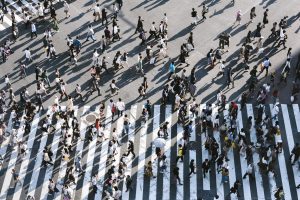
During the pandemic, retailers have had to enforce social distancing and limit the number of shoppers in their stores. A six foot distance between shoppers has become the “new normal” in order to reduce crowding. In retail, crowding is a term used to describe when there are many individuals in a given area which can either encourage or discourage shopping.
Since I prefer shopping in environments where I have space to wander around and browse through items without interruptions or coming into contact with other shoppers, I discovered how much I appreciated the social distancing restrictions indoors. The extra personal space has allowed me to feel safe and more comfortable: I have better visibility inside the store and can avoid coming into contact with another shopper. I used to dread shopping at Costco due to the crowding as there would be too many people crammed in the building. It would be difficult to reach for a shirt in my size or grab cereal as there would be many people surrounding me. I would be less than an arms length away from another shopper. Fortunately, Costco mandated social distancing and reduced capacity indoors giving me more breathing room in the store and the ability reach for things without someone blocking me from what I need.
Hedonic Shopping
One of the most notable changes I’ve experienced as a consumer is how limited my experiences have become with sampling and interacting with luxury products. A hedonic shopping experience is defined as one where, “customers experience enjoyment, excitement, captivation, and escapism from everyday life” (Niosi, 2021). I used to find a lot of pleasure in immersing myself in the shopping experience: but this joy has largely been taken away since many stores no longer permitted trying on clothes, sample food, experimenting with make-up, and even smelling perfumes and colognes. My favorite store to immerse myself in is Sephora. I enjoyed smelling the various products such as setting sprays, creams and perfumes. The smell of the products was enough for me to buy the product instantly. Moreover, sampling the makeup would allow me to ensure that the colour of the products matched my skin or if I liked the texture of the products. The full experience made me joyful as to the great products I would buy were guaranteed to be something that I loved. The image below, shows a woman who is enjoying the excitement and thrill that comes from shopping.
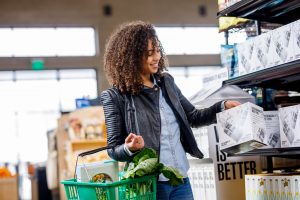
Atmospherics
Atmospherics has always played a significant role in influencing consumers in retail environments. The term refers to, “a situational factor/influence on consumer decision making…” and is defined as, “the sum total of all physical aspects in a retail environment that the retailer controls and should monitor to create a pleasing shopping experience for customers” (Niosi, 2021). Retailers strive to create a shopping environment that can build a relationship with consumers so they come back again. The environment should be more than just a place to engage in a customer transaction: it should host memorable and positive experiences. The photo shown, is an example of a store’s atmosphere as it shows their layout, design and decorations.
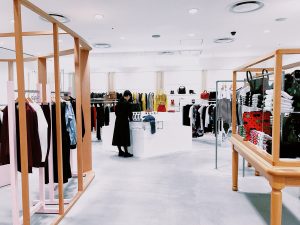
In retail, atmospherics including the physical layout, design, decorations, and aroma, which all influence shoppers. In my experience, I found shopping at retail stores to not be as engaging as they once were. I can no longer smell the beautiful aromas of stores, touch various products, and listen to music. My favorite store atmosphere is IKEA because I enjoy the layout of the store. It allows me to imagine how my future house should look or how my bedroom can look better. With the pandemic, I can no longer touch all the products as it is recommended you touch what you intend to buy. Moreover, every once in a while there are public announcements broadcasted throughout the store to remind everyone of safety protocols to ensure the risk of Covid-19 is minimized. It is hard to imagine spaces in my home when there are various posters regarding physical distancing and mask wearing. For most stores, I found that the music is interrupted with Covid-19 announcements about social distancing, mask wearing and frequent hand washing. H&M has various announcements that interrupt the music. They are important reminders but it disrupts my ability to imagine myself in outfits or escape from the pandemic for a few moments. The arrows on the floor at Walmart direct shoppers up a random aisle and down the next one: I feel this dampers my experience and takes away from the spontaneity and freedom of shopping and being immersed in the store’s atmosphere. as it takes longer to shop and ruins the atmosphere.
Mood
I found that the joy I had shopping was taken away during the pandemic. I no longer feel comfortable in some stores because of my fear of coming into contact with the virus. Shopping begins to feel like a hands-off experience in these “new” cold and distant retail environments. I once loved trying on makeup and sampling different products: now I could not touch the products or sample them to test makeup for a colour match. I could not try on clothes and didn’t feel the risk of buying something ill-fitting was worth it. Our moods affect our buying experiences (and outcomes) because they are temporary feelings we have. Some people use moods to dictate what they buy in hopes it makes them feel better. My mood is fearful and tense because the pandemic scares me. Hearing about exposures on the news worries me and grocery shopping began to feel like a dreaded chore that overwhelms me every week. I shop more when I am happy and when cases go down my mood shifts in a positive direction. The optimism can inspire me to buy outfits that I may wear when the world fully opens up. When I go to Aritzia, I am a generally happy person because I love the clothes and the staff. Due to Covid-19, I do not go to the mall as often anymore. I find that I am very cautious as I am scared of other shoppers having Covid-19. I can not guarantee that all surfaces are wiped down regularly and that everyone follows social distancing rules. The photo below, is an example of a consumer, in a determined and concentrated mood.
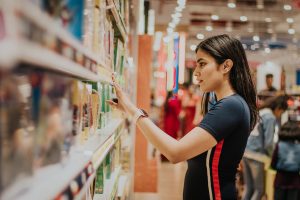
Social Norms
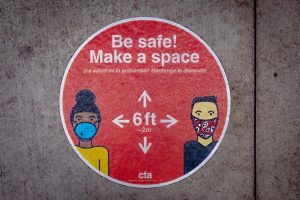
As I mentioned at the start of this piece, the pandemic has introduced a whole new set of social norms into our societies. Social norms are, “socially accepted beliefs about what we do or should do in particular social contexts”(Niosi, 2021). Many of our behaviours that were acceptable prior to Covid-19 are no longer considered acceptable: we strongly discourage coughing in public; we engage in constant hand washing and sanitizing in public; we no longer shake hands with others; and, we continue to maintain safe distancing from others. Over time, these new social norms are becoming permanent features in our society governing what is and what isn’t acceptable. The image shown, is an example of a social norm in the pandemic society where people must maintain a distance of at least six feet.
I understood why we have new social norms as it keeps everyone safe: at times though, it’s felt like a hard adjustment and sometimes giving way to more loneliness. The idea of being unable to gather with my family for birthdays is difficult. I miss being part of events with my cousins as they always made gatherings fun.
Changing social norms have also disrupted many rituals and traditions: Christmas, Thanksgiving, and Diwali have all felt different. Rituals are “a pattern of behaviour that is often in a fixed-sequence and repeated regularly and gives added meaning and significance to a particular culture” (Niosi, 2021). My family does Secret Santa every year, but due to the pandemic, we chose not to do it in 2020. This separation made the holidays a tough time for me. Not being able to be together has forced my family to think of alternative ways of celebrating. We use video call to see each other on special holidays but it does not feel like it used to without all the hugging and storytelling. At Thanksgiving, it was just me, my mom and brother who ate a small meal. Usually, we have my whole family around but this Thanksgiving was a lot quieter than usual. We always play games during Thanksgiving and Christmas but we missed out this year. We always would play trivia games that tested our pop culture knowledge. It was fun to see everyone laugh and make memories. Without all the games, it feels like an empty holiday. Diwali felt empty as we did not celebrate like we did before the pandemic. We lit Diva’s and ate Indian food but we did not have a gathering. We did not play music and dance. It was a dull celebration that made me feel out of place. The photo below shows, a family gathering as a part of a ritual where they meet at the beach during sunset.

Find the words in the grid
| Crowding | Hedonic | Atmospherics | Social Norms |
| Mood | Shopping | Consumerism |
| S | C | I | R | E | H | P | S | O | M | T | A |
| S | E | T | C | U | I | Y | S | N | Q | Y | Z |
| U | A | W | V | Z | D | U | C | R | T | L | K |
| D | F | C | H | Y | C | I | N | O | D | E | H |
| S | E | I | N | C | W | R | G | G | Z | S | D |
| G | Y | D | N | S | S | D | X | F | V | S | K |
| P | C | N | Q | H | F | G | G | D | O | O | M |
| G | M | S | I | R | E | M | U | S | N | O | C |
| W | M | G | P | E | P | N | J | Y | S | H | F |
| G | N | I | P | P | O | H | S | G | N | M | Y |
| E | K | Z | C | R | O | W | D | I | N | G | A |
| S | M | R | O | N | L | A | I | C | O | S | V |
The pandemic has made my shopping experiences change drastically. I am not able to immerse myself in a full shopping experience. Due to the wide spread virus, I have become a more cautious consumer due to fear of getting the virus. Online shopping has become something that I am more interested in as it is the safest option. All of my adaptations are helping me to become the best consumer during one of the scariest times in history.
By Rena Bains (December, 2021)
Media Attributions
- The image of the people walking is by Ryoji Iwata on Unsplash.
- The image of the women shopping is by Boxed Water is Better on Unsplash.
- The image of the retail store is by Korie Cull on Unsplash.
- The image of the women deciding what to buy is by Dollar Gill on Unsplash.
- The image of the 6 feet sign is by Elizabeth McDaniel on Unsplash.
- The image of the family at the beach is by Tyler Nix on Unsplash.
Text Attribution
- Niosi, A. (n.d.). Introduction to Consumer Behaviour is licensed under CC BY-NC-SA-4.0.
when there are many individuals in a given area which can either encourage or discourage shopping.
where customers experience enjoyment, excitement, captivation, and escapism from everyday life.
a situational factor/influence on consumer decision making. It is the sum total of all physical aspects in a retail environment that the retailer controls and should monitor to create a pleasing shopping experience for customers.
refers to the actions that we partake in during our everyday lives that are viewed as acceptable within society. They generalize the accepted way of thinking, feeling, and behaving in a way that our groups support.
a pattern of behaviour that is often in a fixed-sequence and repeated regularly and gives added meaning and significance to a particular culture.

